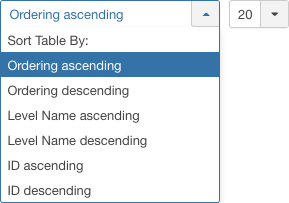Users Access Levels
From Joomla! Documentation
Description[edit]
Provides an overview of the Access Levels available on a Joomla site. The screen is used to find, add, edit and delete Access Levels.
Access levels control which users can view which objects on your site. Objects include menu items, modules, categories, and component items (articles, contacts, and so on). Each object in the site is assigned to one access level. User groups are also assigned to each access level.
If a user is a member of a group that in turn has permission for an access level, then that user can view all objects assigned to that access level. It is important to understand that user groups can be arranged in a parent-child hierarchy. If so, then a child group has access to all access levels that the parent group has access to. So you don't need to assign a child group access to levels that its parent group already has access to.
How to Access[edit]
- Click the Users button in the Control Panel
- Select Viewing Access Levels in the left sidebar.
- Select Users → Access Levels from the dropdown menu of the Administrator Panel.
Screenshot[edit]
Column Headers[edit]
In the table containing Access Levels these are the different columns as shown below. Click on the column heading to sort the list by that column's value.
- Ordering. Up-Down Arrows
 . User specified ordering, default is order of access level creation. When active, drag and drop ordering by 'click and hold' on the bars icon
. User specified ordering, default is order of access level creation. When active, drag and drop ordering by 'click and hold' on the bars icon then 'release' in desired position.
then 'release' in desired position.
- Checkbox. Check this box to select one or more access level. To select all access level, check the box in the column heading.Note: Many toolbar actions can work with multiple access level.
- Level Name. The name of the access level.
- User Groups Having Viewing Access. The groups that have viewing access.
- ID. This is a unique identification number for this access level assigned automatically by Joomla. It is used to identify the access level internally, and you cannot change this number.
Column Filters[edit]
Above the column headers on the right, there are 2 dropdown input fields, Sort Table By: (preset to 'Ordering ascending') and a number (preset to '20') to display.
These column sorting input fields shows the current method of sorting applied to the table. Use the dropdown field choices and click the column heading name. Alternatively, click on the column heading to sort the list by that column's value.
This will also change the value in the drop field to correspond with the column header name. The list will then be sorted in order by that column and a sort icon (up or down arrow) will show next to the column name. Click a second time to reverse the sort, which will change the corresponding drop field.
- Ordering ascending (default). Shows ordering of selected column, ascending or descending.
- Number of access levels to display. Shows the number of access levels to display on one page, default is 20 access levels. If there are more access levels than this number, you can use the page navigation buttons to navigate between pages.
List Filters[edit]
The List Filters are a series of controls that let you limit what access levels show in the screen. More than one filter may be entered. In this case, only access levels that meet all of the filter conditions will show on the list.
Filter by Partial Title or ID
In the upper left is a search field and 2 buttons.
- To filter by partial title, enter part of the title and click 'Search'

- To filter by ID number, enter "id:xx", where "xx" is the ID number (for example, "id:29").
- Click 'Clear' to clear the Filter field and restore the list to its unfiltered state.
Automatic Pagination[edit]
Page Controls. When the number of access levels is more than one page, you will see a page control bar as shown below. The current page number being viewed is shaded.
- Start: Click to go to the first page.
- Prev: Click to go to the previous page.
- Page numbers: Click to go to the desired page.
- Next: Click to go to the next page.
- End: Click to go to the last page.
Toolbar[edit]
At the top left you will see the toolbar.
The functions are:
- New. Opens the editing screen to create a new access level.
- Edit. Opens the editing screen for the selected access level. If more than one access level is selected (where applicable), only the first access level will be opened. The editing screen can also be opened by clicking on the Name of the access level.
- Delete. Deletes the selected access levels. Works with one or multiple access levels selected. Note: You cannot delete an access level that is currently being used. If you try to delete an access level that is assigned, a message showing where it is assigned will be displayed.
- Help. Opens this help screen.
- Options. Opens the Options window where settings such as default parameters can be edited.
Quick Tips[edit]
- Click on the name of an access level to edit it.
- Click on the Column Headers to sort the users by that column, ascending or descending.

